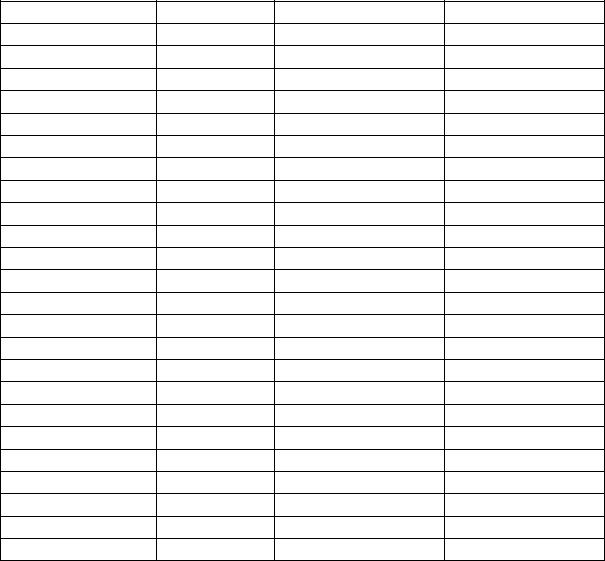
942
.pdf
|
Appendix 9 |
|
Letters Used as Symbols for Quantities |
|
|
Letter |
Quality |
A |
area, mass number |
a |
acceleration |
B |
magnetic flux density |
b |
breadth |
C |
capacitance, heat capacity |
c |
specific heat capacity, velocity of e.m. waves in vacuum, critical angle |
d |
relative density, thickness, distance apart |
E |
energy, electric field strength, electromotive force. Ek kinetic energy, |
|
Ep potential energy, E0 peak e.m.f. |
e |
charge on electron (or proton), an electron |
F |
Faraday constant, force |
f |
frequency, focal length |
G |
free energy conductance |
g |
acceleration due to gravity |
H |
magnetic field strength, magnetizing force, heat of reaction |
h |
height |
I |
intensity of radiation, electric current |
I0 |
peak current |
i |
angle of incidence |
k |
a constant |
L |
self-inductance, latent |
|
heat, Avogadro constant |
Lm |
molar latent heat |
l |
length, specific latent heat |
M |
mutual inductance, molar |
|
solution |
m |
mass, electromagnetic |
|
moment, magnification |
N |
number of molecules, |
|
neutron number |
Na |
Avogadro constant |
N |
a number, refractive index, |
|
number of moles, a neutron |
P |
power |
p |
pressure, order of a spectrum, a proton |
Q |
electric charge |
q |
quantity of heat |
R |
resistance |
Ra |
anode slope resistance, |
|
molar gas constant |
r |
angle of refraction, gas |
|
constant (nR), radius |
s |
distance along a path, slitseparation |
191
T |
period, thermodynamic |
|
(absolute) temperature, |
|
torque, tension, turns ratio |
t |
time |
ts |
half-life |
u |
initial velocity, velocity of molecules, object distance |
V |
volume, electrical potential, potential difference |
Vm |
molar volume |
V |
velocity, image distance, |
|
velocity of sound |
W |
weight |
w |
work |
X |
reactance |
Z |
atomic number |
z |
charge on ion, electrochemical equivalent |
a |
an angle |
|
an increment (finite) |
ε |
permittivity |
η |
efficiency |
θ |
temperature (Celsius), temperature difference, an angle, Bragg angle |
λ |
wavelength, decay constant |
192
Appendix 10
Important Values, Constants and Standards
1.s.t.p. = standard temperature and pressure, expressed as 1.00 atm or 760 mmHg or 101 kPa (= kN m2) (Pa = pascal) and 0°C or 273.15 К
2.Temperature of triple point of water, 273.16 К
3.Gas constant, 8.314 JK -1 mol -1
4.Standard volume of a mole of gas at s.t.p., 22.4 dm3
5.The Faraday constant, F, 9.65 x 104C mol -1
6.The Avogadro constant, L, 6.02 x 1023 mol -1
7.The Planck constant, h, 6.63 x 10 -34Js
8.Speed of light, c, 3.00 x 108 ms -1
9.Mass of proton, 11 H 1.67 x 10-27 kg mass of neutron, 01 1.67 x 10-27 kg mass of electron, e, 9.11 x 10 -31 kg
electronic charge, e,-1.60 x 10 -19 C
10.1 cal = 4.18 J 11.leV = 1.60x 10 -19J
12.Specific heat capacity of water, 4.18 J g - 1 13.Ionic product of water, Kw = 1.008 x 10 -14
K -1
mol2 dm-6, at 289 К (25°C)
193

Appendix 11
Greek Alphabeth
Capital, small |
|
English equivalent |
Russian equivalent |
Αα |
alpha |
a |
Альфа |
Ββ |
beta |
b |
Бета |
Γγ |
gamma |
g |
Гамма |
Δδ |
delta |
d |
Дельта |
Εε |
epsilon |
e(short) |
Эпсилон |
Ζζ |
(d)zeta |
z |
Дзета |
Ηη |
eta |
e(long) |
Эта |
Θθ |
theta |
th |
Тета |
Ιι |
iota |
i |
Йота |
Κκ |
kappa |
k |
Каппа |
Λλ |
lambda |
l |
Лямбда |
Μμ |
mu |
m |
Мю |
Νν |
nu |
n |
Ню |
Ξξ |
xi |
x |
Кси |
Οο |
omicron |
o(short) |
Омикрон |
Ππ |
pi |
p |
Пи |
Ρρ |
rho |
r |
Ро |
Σσ |
sigma |
s |
Сигма |
Ττ |
tau |
t |
Тау |
Υυ |
upsilon |
u |
Ипсилон |
Φφ |
phi |
ph |
Фи |
Χχ |
chi |
ch |
Хи |
Ψψ |
psi |
ps |
Пси |
Ωω |
omega |
o(long) |
Омега |
194

Appendix 12
List of Chemical Elements
Ac |
actinium |
актиний |
Ag |
argentum= silver |
серебро |
Al |
aluminium (US = um) |
алюминий |
Am |
americium |
америций |
At |
argon |
аргон |
As |
arsenic |
мышьяк |
At |
astatine |
астат |
Au |
aurum = gold |
золото |
В |
boron |
бор |
Ba |
barium |
барий |
Be |
beryllium |
бериллий |
Bi |
bismuth |
висмут |
Bk |
berkelium |
беркелий |
Br |
bromine |
бром |
С |
carbon |
углерод |
Ca |
calcium |
кальций |
Cd |
cadmium |
кадмий |
Ce |
cerium |
церий |
Cf |
californium |
калифорний |
Cl |
chlorine |
хлор |
Cm |
curium |
кюрий |
Co |
cobalt |
кобальт |
Cr |
chromium |
хром |
Cs |
caesium |
цезий |
Cu |
copper |
медь |
Py |
dysprosium |
диспрозий |
Er |
erbium |
эрбий |
Es |
einsteinium |
эйнштейний |
Eu |
europium |
европий |
F |
fluorine |
фтор |
Ее |
ferrum=iron |
железо |
Em |
fermium |
(рермий |
Er |
francium |
франций |
Ga |
gallium |
галлий |
Gd |
gadolinium |
гадолиний |
Ge |
germanium |
германий |
195

H |
hydrogen |
водород |
He |
helium |
гелий |
Hf |
hafnium |
гафний |
Hg |
hydrargyrum = mercury |
ртуть |
Ho |
holmium |
гольмий |
I |
iodine |
йод |
In |
indium |
индий |
Ir |
iridium |
иридий |
К |
kalium=potassium |
калий |
Kr |
krypton |
криптон |
Ku |
kurchatovium |
курчатовий |
La |
lanthanum |
лантан |
Li |
lithium |
литий |
Lr |
lawrencium |
лоуренсий |
Lu |
lutetium |
лютеций |
Md |
mendelevium |
менделевий |
Mg |
magnesium |
магний |
Mn |
manganese |
марганец |
Mo |
molybdenum |
молибден |
N |
nitrogen |
азот |
Na |
natrium = sodium |
натрий |
Nb |
niobium = columbium |
ниобий |
Nd |
neodymium |
неодим |
Ne |
neon |
неон |
Ni |
nickel |
никель |
No |
nobelium |
нобелий |
Np |
neptunium |
нептуний |
Ns |
nilsborium |
нильсборий |
О |
oxygen |
кислород |
Os |
osmium |
осмий |
P |
phosphorus |
фосфор |
Pa |
protactinium |
протактиний |
Pb |
plumbum=lead |
свинец |
Pd |
palladium |
палладий |
Pm |
promethium |
прометий |
Po |
polonium |
полоний |
Pr |
praseodymium |
празеодим |
Pt |
platinum |
платина |
Pu |
plutonium |
плутоний |
Ra |
radium |
радий |
Rb |
rubidium |
рубидий |
196

Re |
rhenium |
рений |
Rh |
rhodium |
родий |
Rn |
radon |
радон |
Ru |
ruthenium |
рутений |
S |
sulpher/sulfur (US) |
сера |
Sb |
antimony = stibium |
сурьма |
Sc |
scandium |
скандий |
Se |
selenium |
селен |
Si |
silicon |
кремний |
Sm |
samarium |
самарий |
Sn |
stannum = tin |
олово |
Sr |
strontium |
стронций |
Та |
tantalum |
тантал |
Tb |
terbium |
тербий |
Tc |
technetium |
технеций |
Те |
tellurium |
теллур |
Th |
thorium |
торий |
Ti |
titanium |
титан |
Tl |
thallium |
таллий |
Tm |
thulium |
туллий |
U |
uranium |
уран |
V |
vanadium |
ванадий |
w |
wolfram = tungsten |
вольфрам |
Xe |
xenon |
ксенон |
Y |
yttrium |
иттрий |
Yb |
ytterbium |
иттербий |
Zn |
zinc |
цинк |
Zr |
zirconium |
цирконий |
197
|
|
|
Appendix 13 |
|
|
|
Thermal Expansion, Temperature |
|
|
|
|
Temperature (n) |
|
A property of an object that indicates in which direction heat energy |
|
|
|
|
will flow if the object is placed in thermal contact with another |
|
|
|
object. Heat energy flows from places of higher temperature to |
|
|
|
places of lower temperature. |
Zeroth |
law |
of |
If two bodies Xand Fare each separately in thermal equilibrium |
thermodynarnics |
|
with another body Z, then they are in thermal equilibrium with one |
|
|
|
|
another. In the most common case the body Zis a thermometer. |
Temperature scale |
|
A sequence of values which represent temperature. Such a sequence |
|
|
|
|
is usually obtained by choosing two fixed points (identified by |
|
|
|
specified properties of stated substances) between which there are |
|
|
|
subdivisions made on a chosen basis. The Celsius scale has 99 |
|
|
|
divisions between the melting point of pure water and the boiling |
|
|
|
point of pure water. |
Celsius scale |
|
A temperature scale for which the ice point is at 0° and the steam |
|
|
|
|
point is at 100°. One Celsius degree is denned as 1/100 of the |
|
|
|
temperature interval between the ice point and the steam point. |
Centigrade scale |
|
The name formerly used for the Celsius scale. The name is not now |
|
|
|
|
used in International System of Units (SI) but is often used by |
|
|
|
meteorologists. |
Fahrenheit scale |
|
A temperature scale for which the ice point is at 32° F and the |
|
|
|
|
steam point at 212° F. Originally the zero was obtained in a |
|
|
|
freezing mixture and another point was fixed at 96° for blood |
|
|
|
temperature. |
Reaumur scale |
|
A temperature scale in which the ice point is at 0° and the steam |
|
|
|
|
point at 80°. |
ideal gas scale |
|
A scale in which changes of temperature are measured either by |
|
|
|
|
changes of pressure, or changes of volume, for gases operating at |
|
|
|
pressure low enough for the gases to behave as ideal gases. The |
|
|
|
Celsius temperature в is defined on the scale by: |
|
|
|
θ = (PV)0 - (PV)0 /(PV)100 - (PV)0 100 |
Thermodynamic |
|
A temperature scale which does not depend upon the working |
|
scale |
|
|
properties of any substance. The ideal gas scale is identical with this |
|
|
|
scale. |
Absolute scale |
|
A thermodynamic temperature scale in which the lower fixed point |
|
|
|
|
is absolute zero of temperature and the interval is identic with that |
|
|
|
on the Celsius scale. The temperature on the absolute scale is |
|
|
|
obtained by adding to u, the Celsius temperature, // a where a is the |
|
|
|
coefficient of expansion of a gas at constant pressure. This gives a |
|
|
|
scale on which the ice point is 273.15°; i.e. °A = °C + 273.15. The |
|
|
|
absolute scale was often called the Kelvin scale and temperatures |
|
|
|
measured in °A or °K. In SI units temperature is measured in |
|
|
|
kelvins (K) by defining the triple point of water as 273.16 K. The |
|
|
|
ice point is then 273.15 K. The kelvin has the same size as the |
|
|
|
degree absolute. |
198
Fixed points |
Those points on a temperature scale which are fixed and which can |
|
|
be referred to a given property of a substance. The two main fixed |
|
|
points are the ice point and the steam point. |
|
Ice point |
That fixed point on a temperature scale at which pure solid water |
|
|
(ice) and pure liquid water are in equilibrium at 101 325 N m2 (760 |
|
|
mm Hg). It maybe more simply described as the melting point of |
|
|
pure ice at standardpressure (101 325 N nr2 or 760 mm Hg). |
|
Steam point |
That fixed point on a temperature scale at which pure water boils at |
|
|
standard pressure (101 325 N nr2; 760 mm Hg). This is 100° on the |
|
|
Celsius scale. |
|
Zinc point |
A fixed point on an international temperature scale, fixed at the |
|
|
temperature at which zinc changes from liquid to solid (the freezing |
|
|
point of zinc) at standard pressure (101 325 N nr2). This |
|
|
corresponds to 419.58 °C. |
|
International |
A practical scale which is as near as possible to the thermodynamic |
|
temperature scale |
scale but easily referable to a series of fixed points. |
|
|
Triple point of hydrogen |
-259.34 °C |
|
Boiling point of neon |
-246.048 °C |
|
Triple point of oxygen |
-218.789 °C |
|
Boiling point of oxygen |
-182.962 °C |
|
Triple point of water |
0.0 ГС |
|
Boiling point of water |
100.0 °C |
|
Freezing point of zinc oil |
419.58 °C |
|
Freezing point of silver |
961.93 °C |
|
Freezing point of gold |
1064.43 °C |
|
Below 630°C platinum resistance thermometer; up to 1064°C a |
|
|
thermocouple or special platinum resistance thermometer; above |
|
|
1064 °C a radiation pyrometer. |
|
199
Appendix 14
List of International Words
abberation |
azimuth |
centrifugal |
abiotic |
bacterium |
chemical |
abscissa |
barrier |
chemist |
abstract |
biatomic |
chicory |
accelerate |
bifurcation |
chlorophyll |
accumulate |
binary |
chromosome |
acetate |
binominal |
chord |
acre |
biochemistry |
chrome |
acyclic |
biogenetic |
circulation |
adequate |
bio mass |
coagulation |
aeration |
biophysics |
coefficient |
aerobe |
biosphere |
collapse |
agglomerate |
bomb |
colloid |
aggregate |
boolean |
compact |
allomorph |
briquette |
component |
amalgam |
buffer |
compost |
ammonia |
bushel |
concentric |
amorphism |
calcic |
conglomeration |
amphibian |
calculate |
conjunction |
anabolism |
caliber |
coordinate |
anaerobe |
calibrate |
copernican |
androgenesis |
calorie |
corpuscle |
anode |
camphor |
corrode |
anomalous |
canal |
cosecant |
antioxidant |
capillary |
cosine |
apical |
capsule |
cotangent |
apparatus |
carat |
covalence |
Archimedus |
carbide |
crater |
Aristotel |
carbon |
criterion |
artesian |
carburettor |
crystallize |
asphalt |
carotene |
cube |
associate |
catalysis |
cultivate |
atmosphere |
category |
cybernetics |
attribute |
cathode |
cyclic |
autoclave |
cellulose |
cyclone |
automorphous |
cement |
cylinder |
autotrophic |
centigrade |
cytology |
axiom |
ceramic |
date |
200
